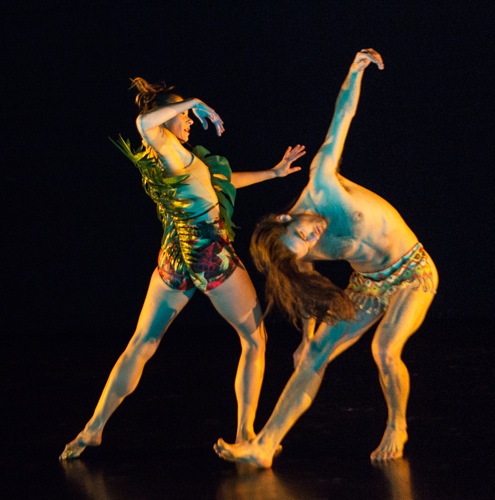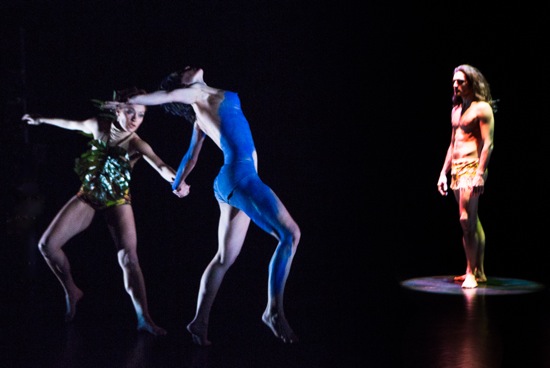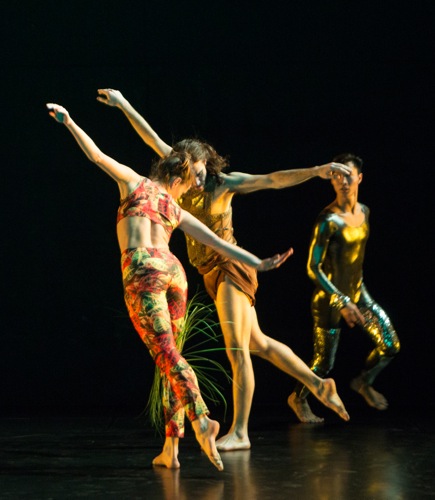Rashaun Mitchell premieres his Light Years at New York Live Arts, April 1 through 4.
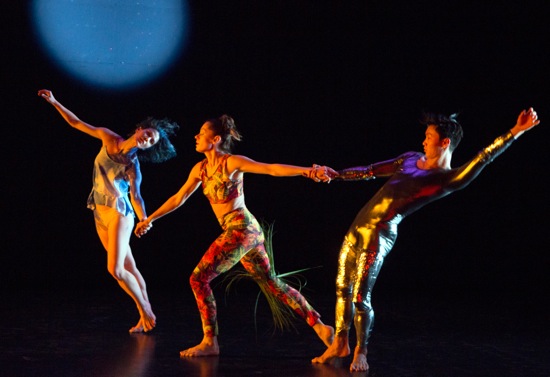
(L to R): Cori Kresge, Melissa Toogood, and Hiroki Ichinose in Rashaun Mitchell’s Light Years. Photo: Yi-Chin Wu
Here are some of the thoughts that popped up when I was watching Rashaun Mitchell’s Light Years at New York Live Arts: evolution, planetary orbits, outer space, Adam and Eve, video-game warriors, science fiction. These images continue to pursue their separate, but sometimes related paths through my mind—occasionally colliding, knocking one another off course, or flickering out. That’s how the four dancers who perform Light Years carry on too.
Mitchell, a compelling performer during his eight years in the Merce Cunningham Dance Company and in works by many others, usually appears in his own pieces and in his collaborative ventures with Silas Riener. He does not dance in Light Years. Instead, he has worked to bring out individual qualities of former Cunningham colleagues Riener and Melissa Toogood, Cori Kresge (who taught at the Cunningham School and was a member of the Merce Cunningham Repertory Understudy Group); and Hiroki Ichinose, a fairly recent graduate of NYU-Tisch School of the Arts. Stepping outside what he is creating seems to be a necessary step for Mitchell in terms of further developing his choreographic vision.
In assembling Light Years, Mitchell has had inspired assistance, and not just from the dancers. Davison Scandrett’s lighting, Michael Beharie and Corwin Lamm’s music, and the costumes by Mitchell, Riener, and Julia Donaldson help shape our perceptions. The resulting piece is fascinating, exciting, bewildering, and sometimes exasperating (it has its occasional longueurs and moments when it itself seems to be veering off-course).
Riener begins alone and in dim light; bare-chested and wearing only a very short flap of printed fabric in front and nothing in back, he walks in a circle around a rotating disk of pinkish patterned light about a yard in diameter (the image has been projected on the stage floor ever since the theater’s doors opened). His long mane of hair hangs loose. As he walks in silence, the projection enlarges to meet his path. Maybe it’s a planetary map. As he walks, his posture begins to change in various ways—not as if he were developing something, but as if he’s presenting postural snapshots.
Mitchell encourages us to see what we will, interpret it as we may. Watching Riener walk, I remember Elizabeth Kolbert in her The Sixth Extinction remarking that although Neanderthals vanished from the earth about 30,000 years ago, most of us should know that they reside in up to 4 percent of our DNA.
The dancers in Light Years often stay only a few seconds onstage; their paths brought them here, but they have business elsewhere. Sometimes when they share the stage, they seem not to see one another. The music, which only begins with Toogood’s first brief entrance, follows its own course, sometimes falling silent; over the course of the piece, you may hear a high whining, bass musical jabs, growls, blurry rhythmic thuds, something like falling hail, something that sounds like an airplane taking off.
These performers, functioning as independent contractors who are surprised to find one another working on the same project, could also have come from different eras or planets. Toogood’s two-piece outfit printed with fiercely colored leaves has a palm frond attached to it in front and another in back. I’m tempted to see her and Riener as a jungle-bred Adam and Eve, but resist the urge (Tarzan and Jane? Best to forget such conjectures). When Kresge joins these two onstage, she’s wearing mostly irregularly applied blue paint, like a Pict of ancient Scotland; her hair is blue too. In the course of their dancing, Toogood suddenly clasps Kresge’s hand and yanks her along, while Riener stands at a dispassionate distance. Kresge leaves the other two alone together, discovering each other. The lighting at this point makes them look like the most beautiful people in the world. They dance fast and furiously in not quite identical ways. Then, holding both each other’s hands, they spin themselves off the stage.
The lights are dim when Ichinose appears. Gleaming. Is that a helmet on his head, matching his silvery unitard? Peering into the darkness, you might think he’s a robot warrior escaped from a video game. He has his own way of moving—sometimes jerky, but more often sinuously elastic. He gazes around, jutting his head out like a turtle. An alien from light years in the future inspecting a strange land? Mitchell—although he’s definitely not telling stories— must not be averse to making a spectator feel this.
I also think of galaxies, of tangential orbits, of meetings across greater space than New York Live Arts provides. Cresge reappears, having acquired a very short tunic, also stained blue. As she wheels and tilts about the space, tiny dots of light fall on her—dancing along her arm, spattering her shoulders. The floor becomes covered with stars. Later, an immense red circular shape climbs the back wall, and a couple of smaller “moons” change positions and/or disappear.
The performers alter their appearances too. Riener returns in a lumpy brown loincloth and a brown top (in the dress rehearsal photos, he wears something like a Roman warrior’s vest). Ichinose sheds what turns out to be a fabric hood. Toogood loses her palm branches, but reappears with a small bunch of grasses tied to one of her legs.
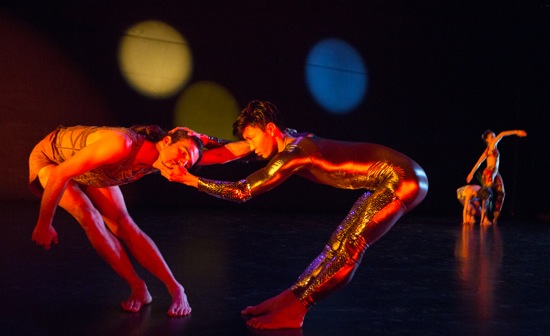
Silas Riener and Hiroki Ichinose in Rashaun Mitchell’s Light Years. At back: Cori Kresge and Melissa Toogood. Photo: Yi-Chun Wu
All four of these fascinating people dance strenuously—taking to the air, falling to the ground, impressing gestures on the space; they’re sleekly expert, but also awkward, disjointed wavering. Small gestures, like a hand pressed to a brow, alternate or combine with larger, more space-devouring steps. At one point, Reiner throws himself around in big, loose movements, kicking out his legs. The amazing Toogood moves as if she is investigating two terrains simultaneously: the one around her and her own body’s information. These people give you the sense that they’re journeying through movements that they’ve known—a kind of involuntary inventory. Movements fall onto them the way the points of light fall on Kresge. A remembered gesture may dissolve into one not originally associated with it.
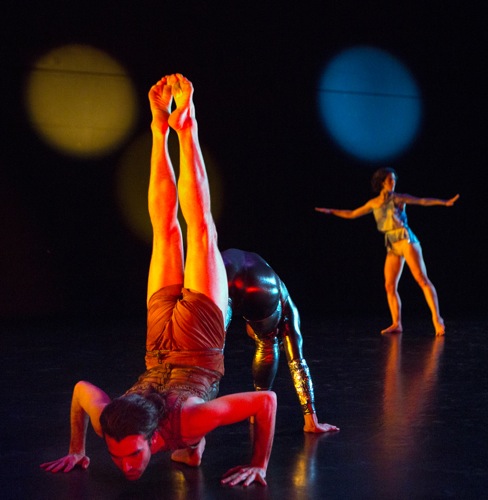
(L to R): Silas Riener, Hiroki Ichinose, and Cori Kresge in Rashaun Mitchell’s Light Years. Photo: Yi-Chun Wu
The dancers don’t fit together easily either. Ichinose’s neck gets caught in the crook of Riener’s elbow, and neither they nor you understand exactly how or why that happened. Watching the two women together, I catch a flurry of motion from the men, and I turn my eyes toward them just in time to see Riener sliding headfirst down the slant of Ichinose’s lunging body. The complexity and the intensity reach a pitch, emphasized by sound and light. Suddenly silence and stillness, and Riener alone again, walking his circle, this time very rapidly. Is this the end? It could be—maybe should be—but no. There’s another burst of activity.
The final moment is both brilliant and faintly corny. I like that it can be those two things at once. Blue lights suddenly shine down on us, the spectators. The dancers stop dead and turn their heads to stare at us. Blackout.
Who is light years away from whom? How many worlds are we talking about here? How many galaxies reside in our DNA?

